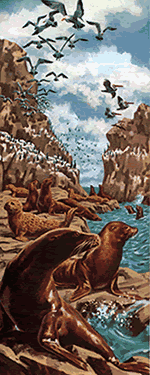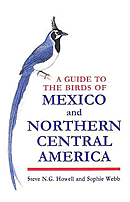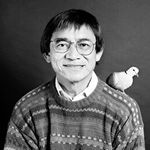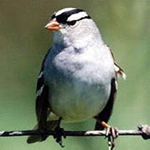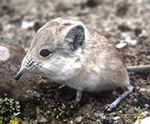The Department of Ornithology and Mammalogy was established in 1853 with the creation of the California Academy of Sciences. After the 1906 earthquake and fire, which destroyed most of the original collections of birds and mammals, the department was reborn with the resurrection of the new Academy of Sciences. As a world renown repository for specimens and their accompanying information, the department's collections currently house over 100,000 specimens of birds and over 30,000 specimens of mammals. The department also houses a modern bioacoustics laboratory and an extensive sound library of over 4,000 recordings. SCOPE
& COVERAGE The department contains one of the world's largest collections of marine mammals with several thousand specimens of seals, sea lions, whales, dolphins, sea otters, and sirenians. We are also actively involved in the Marine Mammal Stranding Network, a cooperative organization of several scientific and government institutions that aim to increase knowledge of marine mammals through scientific investigation, collection, and education. IMPORTANCE
of the COLLECTIONS Museum specimens also yield valuable and unique biological information about a species, as well as providing crucial samples for DNA research, isotopic studies, toxological analysis, and archaeological identifications. More importantly, data from our specimens are used by universities, government agencies, conservation groups, and international governments to draft management plans, establish reserves, restore habitats, and protect endangered species. The collections have been accredited by the American Society of Mammalogists, and have maintained a high ranking with the American Ornithological Union Survey of Museum Collections. Staff and associates of the Department of Ornithology and Mammalogy are actively involved in many different areas of scientific research around the world. These include ongoing behavioral studies involving vocalization and learning in birds, studies of their mating and breeding behavior, and systematics and evolutionary ecology of living birds; systematics and paleontology of fossil birds and mammals, ecological and biogeographical studies of marine mammals; biological surveys of California birds and mammals; cooperative international biodiversity surveys; and captive breeding and conservation of birds.
IN
MEMORIAM It is with profound sadness that we announce the death of Dr. Luis Baptista who served as Chair and Curator of our Ornithology and Mammalogy Department for nearly twenty years. Luis spent many years studying the mating habits, songs and language of birds and became a leading expert in this field. He could identify the sounds of the more than 150 bird species in Golden Gate Park, and he knew and loved all of them. The author and co-author of more than 127 publications in ornithology, he was a prolific scholar. Each day, Luis enriched the lives of everyone who surrounded him. His enthusiasm, brilliant mind, and unassuming graciousness will be greatly missed. Charitable contributions to promote and continue avian research can be sent to the Luis Baptista Memorial Fund, California Academy of Sciences, Golden Gate Park, San Francisco, CA 94118. |
|||||||||||||||||||||||||||||

